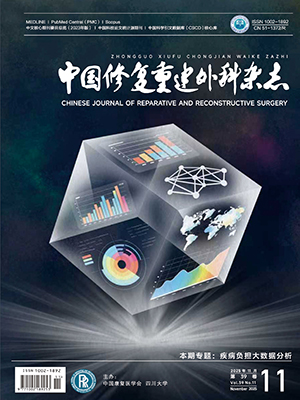Objective To provide the anatomic basis for thedesign of the intermediate dorsal neurocutaneous flap on the foot and to reportthe clinical results. Methods On 32 adult cadaver lower limb specimens perfused with red latex, the origins, diameters, courses, branches, and distributions of the intermediate dorsal cutaneous nerve of the foot and its nutrient vessels were observed. On this anatomic basis, from June 2004 to October2005, 5 flaps were developed and applied to the repair of the soft tissue defect in the feet of 4 patients. Results The intermediate dorsal cutaneous nerve of the foot was found to arise from the superficial peroneal nerve. Crossing the intermalleolar line, it was located 1.3±0.6 cm lateral to the midpoint of the line with a diameter of 2.05±0.56 mm. The nerve stem divided into branches 2.8±1.3 cm distal to the line. They distributed the dorsal skin of the second, third and fourth metatarsal and toe. On average, 5.1 perforators per specimen were identified. At least 3 nutrient vessels were always found in each. They originated from the cutaneous branches of the anterior tibial artery and the dorsalis pedis artery in the proximal end and the dorsalis metatarsal artery in the distal end. They perforated the deep fascia 4.3±0.4 cm proximal to the intermalleolar, 1.6±0.3 cm proximal to the tip of the third toe webspace and 1.5±0.3 cm proximal to the tip of the forth toe webspace, respectively. The external diameters of them were 0.82±0.13, 0.42±0.07 and 0.49±0.09 mm, respectively. The patients were followed up for 4-10 months. All theflaps survived completely. Their appearance and function were satisfactory. Conclusion The distallybased intermediate dorsal neurocutaneousflap on the foot has an abundant blood supply. This kind of flap is especially useful in repair of the soft tissue defect in the foot.
Citation: WU Nongxin,XU Yongqing,LI Jun,et al.. ANATOMICAL STUDIES AND CLINICAL APPLICATIONS OF DISTALLY-BASED INTERMEDIATE DORSAL NEUROCUTANEOUS FLAP ON THE FOOT. Chinese Journal of Reparative and Reconstructive Surgery, 2007, 21(4): 363-366. doi: Copy
Copyright © the editorial department of Chinese Journal of Reparative and Reconstructive Surgery of West China Medical Publisher. All rights reserved




